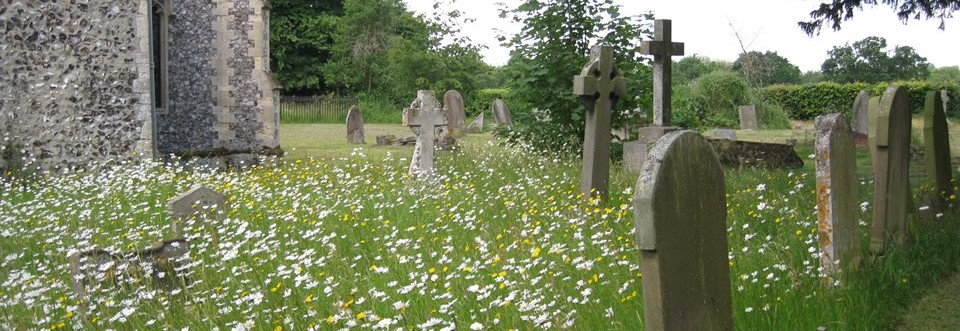Our churchyards are safe havens for a wealth of species, some of which are rare and/ or protected. The below links offer advice on how to encourage, protect and promote biodiversity and how to discover what your churchyard is home to.
Caring for God’s Acre provides a wide range of resources to assist with sensitive churchyard management.

Norfolk Wildlife Trust’s Churchyard Conservation Scheme
Norfolk was historically rich in lowland meadows and the beautiful and diverse displays of wildflowers that this ancient habitat supports. This was at a time before agricultural intensification, with meadows being managed in traditional ways such as for grazing or hay cutting, allowing wildflowers to flourish. However, since the Second World War this low-intensity, sympathetic management has been replaced by widespread application of fertilisers, herbicides and large-scale reseeding and ploughing up of meadowland. It is estimated that since 1945, 98 percent of our wildflower meadows once widespread in the countryside have now vanished.
Nowadays, churchyards often form the only remaining fragments of old wildlife-rich meadow in a parish, serving as island refuges for local wildlife, including birds, butterflies, bees, hedgehogs and slow-worms to name a few. There are six species of meadow plant that are now deemed dependent on churchyards for their survival in Norfolk and a number of churchyards even support orchid populations if allowed to survive the spring and summer months.
Recognising this, the Norfolk Wildlife Trust Churchyard Conservation Scheme was set-up over 30 years ago with the aim of encouraging and supporting churches to manage their churchyards with wildlife in mind so that they may continue to offer sanctuary in our ever fragmented and degraded landscapes.
Under the scheme, it has surveyed and given free advice to hundreds of churches in Norfolk. Each year a team of dedicated volunteer churchyard surveyors visit dozens of churchyards to survey them and identify the best areas for wildflowers and other wildlife. They then provide a report giving detailed results, along with some basic and clear advice on how parts of the churchyard could be managed for wildlife (such as establishing a Conservation Area), whilst ensuring the churchyard remains cared-for, accessible and able to perform its primary purpose, promoting the area as a place of refuge for both people and wildlife. If a church would like to manage a part (or in some cases all!) of their churchyard for wildlife, then they can become part of the scheme and display a Norfolk Wildlife Trust Churchyard Conservation Scheme plaque.
The service is free and more information can be found here.
If you would like to be added to the list of churchyards to be surveyed next year, receive an information pack or have any questions, please email churchyards@norfolkwildlifetrust.org.uk or call 01603 625540.
DOs
- Leave areas of the oldest graves uncut from April until end July/early August. Then cut and REMOVE the grass cuttings. Repeat in October if resources allow. This will allow any meadow plants in the seedbank to grow, flower and set-seed. Sometimes species can come up that have been dormant for decades.
- Leave a strip of vegetation along one side uncut until October each year. This strip can act as a refuge and food source for a range of invertebrates, small mammals, reptiles and amphibians.
- Leave a few holes in walls or fences, as well as any ‘untidy corners’. It will allow access to and from the churchyard, as well as refuge/hibernation opportunities for hedgehogs.
- Pile any dead wood/branches into an undisturbed corner. An often-overlooked habitat that supports a huge array on invertebrates.
- Put up bird and bat boxes in churchyard trees to provide safe nesting / roosting.
- Keep grass paths and areas of tended graves mown regularly. Mow a neat edge to gravel paths and any conservation areas. It will maintain access, neatness and signals intentionality rather than neglect.
- Put up signs telling visitors why an area is being left. This will raise awareness of the importance of the churchyard for local wildlife and encourage visitors.
DON’Ts
- Spray herbicides and pesticides. It may kill native wild flora and/or pollinators and invertebrates that are food e.g. for hedgehogs.
- Scrub tombstones to remove lichen. Churchyards are a haven for lichen in Norfolk, due to the lack of natural rocky outcrops.
- Cut trees and hedges every year, and especially not during the bird breeding season (March – August). Hedgerows support numerous species of invertebrate, small mammal and bird amongst other groups. They provide shelter, food and a safe place to nest. Try to cut only every three years.
Wildlife in church buildings
Church buildings also provide a home to wildlife!
